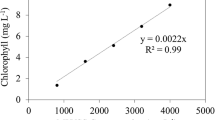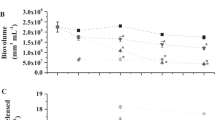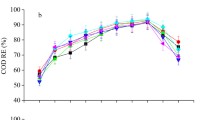Abstract
The main objective of this research was to study the feasibility of using algal and algal-activated sludge systems in treating laundry wastewater. Three different types of systems—green microalgae (system A), diatoms + activated sludge (system B), and green microalgae + activated sludge (system C)—were studied at six different solid retention times (SRT)—6, 8, 10, 12, 14, and 16 days—to evaluate their performance in removal of total organic carbon (TOC), total nitrogen (TN), anionic surfactants, and micropollutants with added trace elements. System B showed relatively better performance in removal of TOC (79%) and TN (90%). A total of 64 compounds were detected in influent when analyzed by LC-MS, of which 19 were grouped under herbicides, pesticides, and insecticides, 25 under pharmaceuticals, and 20 under others. Linear alkylbenzene sulfonate (LAS) was detected only in the effluent of system A and was not detected in both system B and system C. Grotan OX, an anti-microbial, was the compound with least removal in all the systems. The bacterial LAS degrader/tolerant plate count in system B at 16-day SRT was 2000 CFU/mL, 50 times more than the plate count of system C (40 CFU/mL). The LAS degrader/tolerant bacterial species identified were Aeromonas caviae and Klebsiella pneumonia in both systems B and C. The LAS degrader/tolerant green microalgae plate count at 16-day SRT was 130 CFU/mL, whereas no LAS degrader/tolerant diatom colonies were observed.

Graphical Abstract





Similar content being viewed by others
References
APHA/AWWA/WEF (2012). Standard methods for the examination of water and wastewater. Stand Methods, 541. ISBN 9780875532356.
Braga, J. K., & Varesche, M. B. A. (2014). Commercial laundry water characterisation. American Journal of Analytical Chemistry, 05, 8–16. https://doi.org/10.4236/ajac.2014.51002.
Figueira, V., Vaz-Moreira, I., Silva, M., & Manaia, C. M. (2011). Diversity and antibiotic resistance of Aeromonas spp. in drinking and waste water treatment plants. Water Research. https://doi.org/10.1016/j.watres.2011.08.021.
García, M. T., Campos, E., Ribosa, I., Latorre, A., & Sánchez-Leal, J. (2005). Anaerobic digestion of linear alkyl benzene. sulfonates: biodegradation kinetics and metabolite analysis. Chemosphere, 60, 1636–1643. https://doi.org/10.1016/j.chemosphere.2005.02.048.
Ghaitidak, D. M., & Yadav, K. D. (2013). Characteristics and treatment of greywater-a review. Environmental Science and Pollution Research. https://doi.org/10.1007/s11356-013-1533-0.
Imhof, B., & Muhlemann, J. (2005). Greywater treatment on household level in developing countries–A state of the art review. Zurich: Department of Environmental Sciences at the Swiss Federal Institute of Technology (ETH).
Katam, K., & Bhattacharyya, D. (2017). Biodegradation of laundry wastewater under aerobic and anaerobic conditions: a kinetic evaluation. Water Environmental Research. https://doi.org/10.2175/106143017x14902968254638.
Ko, W. C., Paterson, D. L., Sagnimeni, A. J., Hansen, D. S., Von Gottberg, A., Mohapatra, S., Casellas, J. M., Goossens, H., Mulazimoglu, L., Trenholme, G., Klugman, K. P., McCormack, J. G., & Yu, V. L. (2002). Community-acquired Klebsiella pneumoniae bacteremia: global differences in clinical patterns. Emerging Infectious Diseases. https://doi.org/10.3201/eid0802.010025.
Kumar, S., Mukhopadhyay, P., Samaddar, D., Bandyopadhyay, M. K., Bandyopadhyay, M., Chatterjee, M., & Ghosh, T. (2013). Necrotizing fasciitis caused by Aeromonas caviae. Avicenna Journal of Medicine. https://doi.org/10.4103/2231-0770.110740.
Li, M., Zhu, W., Dai, X., & Li, X. (2013). Effects of linear alkylbenzene sulfonate on extracellular polysaccharide content and cells per particle of Microcystis aeruginosa and Scenedesmus obliquus. Fresenius Environmental Bulletin.
Markou, G., Vandamme, D., & Muylaert, K. (2014). Microalgal and cyanobacterial cultivation: the supply of nutrients. Water Research. https://doi.org/10.1016/j.watres.2014.07.025.
Mohan, P. K., Nakhla, G., & Yanful, E. K. (2006). Biokinetics of biodegradation of surfactants under aerobic, anoxic and anaerobic conditions. Water Research, 40(3), 533–540.
Morel, A., & Diener, S. (2006). Greywater management in low and middle-income countries, review of different treatment systems for households or neighbourhoods. Dübendorf: Eawag.
Nirmalakhandan, N., Selvaratnam, T., Henkanatte-Gedera, S. M., Tchinda, D., Abeysiriwardana-Arachchige, I. S. A., Delanka-Pedige, H. M. K., Munasinghe-Arachchige, S. P., Zhang, Y., Holguin, F. O., & Lammers, P. J. (2019). Algal wastewater treatment: photoautotrophic vs. mixotrophic processes. Algal Research. https://doi.org/10.1016/j.algal.2019.101569.
Ogbulie, T. E., Ogbulie, J. N., & Umezuruike, I. (2008). Biodegradation of detergents by aquatic bacterial flora from Otamiri River, Nigeria. African Journal of Biotechnology, 7, 824–830.
Padhi, S. K., Tripathy, S., Sen, R., Mahapatra, A. S., Mohanty, S., & Maiti, N. K. (2013). Characterisation of heterotrophic nitrifying and aerobic denitrifying Klebsiella pneumoniae CF-S9 strain for bioremediation of wastewater. International Biodeterioration and Biodegradation. https://doi.org/10.1016/j.ibiod.2013.01.001.
Rowsell, V. F., Tangney, P., Hunt, C., & Voulvoulis, N. (2010). Estimating levels of micropollutants in municipal wastewater. Water, Air, and Soil Pollution, 206, 357–368. https://doi.org/10.1007/s11270-009-0112-y.
Sáez, M., Gómez-Parra, A., & González-Mazo, E. (2001). Bioconcentration of linear alkylbenzene sulfonates and their degradation intermediates in marine algae. Fresenius’ Journal of Analytical Chemistry, 371(4), 486–490.
Su, Y., Mennerich, A., & Urban, B. (2011). Municipal wastewater treatment and biomass accumulation with a wastewater-born and settleable algal-bacterial culture. Water Research. https://doi.org/10.1016/j.watres.2011.03.046.
Wang, L. (1976). Colorimetric method for the analysis of residual anionic or cationic surfactants. US Pat. 3,992,149.
Funding
This research was funded by the Japan International Cooperation Agency under Collaboration Kick-starter Program.
Author information
Authors and Affiliations
Corresponding author
Ethics declarations
Conflict of Interest
The authors declare that they have no conflict of interest.
Additional information
Publisher’s Note
Springer Nature remains neutral with regard to jurisdictional claims in published maps and institutional affiliations.
Rights and permissions
About this article
Cite this article
Pandey, A., Katam, K., Joseph, P. et al. Micropollutant Removal from Laundry Wastewater in Algal-Activated Sludge Systems: Microbial Studies. Water Air Soil Pollut 231, 374 (2020). https://doi.org/10.1007/s11270-020-04749-x
Received:
Accepted:
Published:
DOI: https://doi.org/10.1007/s11270-020-04749-x




